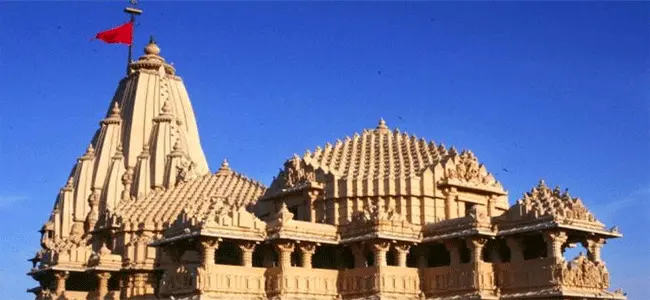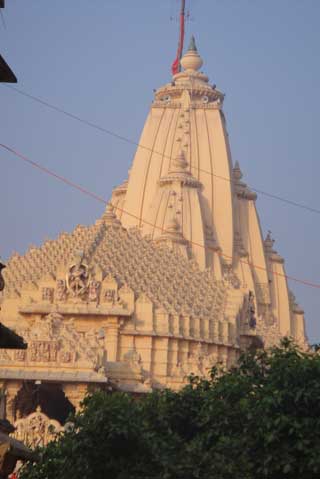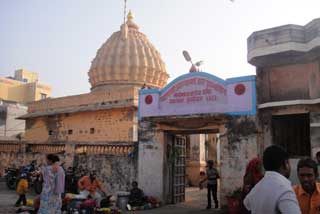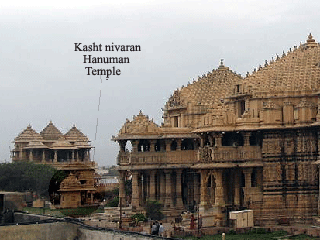
Legend behind the name Somnath
 Daksha Prajapathi had twenty-seven daughters and he got all his daughters married to Lord Chandra (Moon). Out of all his wives, Chandra used to show more attention and love towards Rohini and neglected others. His other wives were pained by Chandra’s attitude towards them and complained to their father Daksha Prajapathi. On hearing about this, Daksha Prajapathi became angry with Chandra and cursed him to lose his luster and suffer from a dreadful skin disease. As a consequence of this disease, Chandra started waning each day and almost lost his radiance and glory. On the advice of Brahma, Chandra prayed to Lord Shiva by undertaking a severe penance and seeking the blessings of Lord Shiva to ward off the curse of Daksha Prajapathi. He selected the holy kshetra of Somnath [where one of the 12 jyothir linghas of Lord Shiva is housed] on the western coast for his penance.
Daksha Prajapathi had twenty-seven daughters and he got all his daughters married to Lord Chandra (Moon). Out of all his wives, Chandra used to show more attention and love towards Rohini and neglected others. His other wives were pained by Chandra’s attitude towards them and complained to their father Daksha Prajapathi. On hearing about this, Daksha Prajapathi became angry with Chandra and cursed him to lose his luster and suffer from a dreadful skin disease. As a consequence of this disease, Chandra started waning each day and almost lost his radiance and glory. On the advice of Brahma, Chandra prayed to Lord Shiva by undertaking a severe penance and seeking the blessings of Lord Shiva to ward off the curse of Daksha Prajapathi. He selected the holy kshetra of Somnath [where one of the 12 jyothir linghas of Lord Shiva is housed] on the western coast for his penance.
Pleased with Chandra’s penance, Lord Shiva appeared before him in the form of Jyothi and bestowed him with partial relief from the disease he was suffering from. As the effect of the original curse cannot be undone, the relief provided by Lord Shiva led to Chandra being bright gradually for fifteen days (called the waxing period – Sukla Paksha) and on his attaining full radiance at the end of this period of fifteen days (Poornima) the curse will take its toll, by reducing his luster gradually over the next fifteen days (called the waning period – Krishna Paksha) till he becomes virtually dark at the end of this period (Amavasya).
As Chandra had regained his luster (Prabha) by his sheer austere penance, this holy place came to be known as Prabhasa Kshetra (Prabhas Patan). Lord Shiva at this kshetra is known as Somanatheeswara - named so for blessing Chandra whose other name is Soma. This Shiva Linga is considered as the Aadi Jyothirlinga.
Legend of Somnath Temple
The temple is in existence from time immemorial. Tradition has it that the glory of this kshetra has been mentioned in Rigveda. The place and the glory of Lord Shiva are mentioned in Shiva and the Skanda Puranas.
One could see the entrance to this temple marked as ‘Maharani Ahilyabai entrance’. It is presumed that during this time a temple for Sri Hanuman was also built on the boundary of this new temple. The temple for Sri Hanuman is believed to have been built in recognition of the fact that He gave all the Hindu kings/queens the courage and conviction that they can build the temple without any hindrance.
It is Chandra who had done the ‘prana prathishta’ to the Shivalinga [Jyothirlanga] after installing the same on the Brahmashila slab. It is believed that the idol and the inner portions of the shrine were decorated in Gold by Chandra. Afterward, Ravaneswara is believed to have rebuilt the temple in silver. During Lord Sri Krishna’s time, he is believed to have renovated the temple in sandalwood. It is in Somnath- at Balika Teerth – that Lord Krishna is believed to have ended his avatar on the earth after he was accidentally hit by an arrow from a hunter.
The richness of this temple attracted the attention of the Islamic invaders of the country and the temple was plundered for its wealth many times. Details of the richness of the temple have been described in “Hindu World – An Encyclopedic Survey of Hinduism” by a British historian named Benjamin Walker.
Architecture of the temple then
Zakariya al-Qazwini, a 13th-century Arab geographer while writing about the temple had mentioned as follows: “Somnath: celebrated city of India, situated on the shore of the sea, and washed by its waves. Among the wonders of that place was the temple in which was placed the idol called Somnath. This idol was in the middle of the temple without anything to support it from below, or to suspend it from above. It was held in the highest honour among the Hindus, and whoever beheld it floating in the air was struck with amazement, whether the on-looker was a Musalman or an infidel. The Hindus – in tens of thousands - used to go on pilgrimage to the city whenever an eclipse of the moon occurred.”
Architecture of the temple now
Presently the temple – built in Chalukya style – is housed at the very same site in which the original and ancient Somnath temple stood. Sardar Vallabhbhai Patel, the then Deputy Prime Minister of India – remembered fondly as the ‘Iron Man of India’ - was primarily responsible for the construction of the present-day temple. Under the banner ‘Shree Somnath Trust’ the present temple was reconstructed with funds raised from the public. Sri K.M. Munshi, as the Chairman of the trust had overseen the task of getting the temple construction completed as aspired by Sardar and others. The present temple is built in the Chalukya style of temple architecture or Kailash Mahameru Prasad Style and reflects the skill of the Sompura Salats - Gujarat's master masons.
Even now some of the remains of the old temple where Maa Parvati was enshrined could be seen by the side of the present temple.
The unique positioning of the Temple
 The temple is situated at such akshamsa [latitude] and rekamsa [longitude] that there is no land in a straight line between Somnath seashore and Antarctica- not even a tiny island. An inscription in Sanskrit, to this effect, is found on the Arrow-Pillar [Baan-Stambh] erected on the sea-protection wall of the Somnath Temple. This Baan-Stambh mentions that it stands at a point on the Indian landmass, which happens to be the first point of land in the north to the south pole on that particular longitude.
The temple is situated at such akshamsa [latitude] and rekamsa [longitude] that there is no land in a straight line between Somnath seashore and Antarctica- not even a tiny island. An inscription in Sanskrit, to this effect, is found on the Arrow-Pillar [Baan-Stambh] erected on the sea-protection wall of the Somnath Temple. This Baan-Stambh mentions that it stands at a point on the Indian landmass, which happens to be the first point of land in the north to the south pole on that particular longitude.
Other shrines in the temple complex
Other temples located inside the complex of Somnath Mandir are Shri Kapardi Vinayak and Sri Hanuman Temple. Sri Kapardi Vinayak shrine is situated on the right corner of the complex as one enters the complex. It is customary to offer our first prayers to Sri Vinayak before entering the main shrine of Sri Somnath. The shrine of Sri Hanuman is on the right side of the main path leading to the shrine of Sri Somnath.
Shrine of Sri Hanuman
 Photo courtesy: Wikipedia
Photo courtesy: Wikipedia
Somnath temple has a long history of being demolished and then again reconstructed many times. Many Hindu kings had taken pains to renovate the temple each time it was damaged. Aurangzeb during his time converted the temple into a mosque. After that in a joint effort of Peshwa of Pune, Raja Bhonsle of Nagpur, Chhatrapati Bhonsle of Kolhapur, Queen Ahilyabai Holkar of Indore & Shrimant Patilbuwa Shinde of Gwalior rebuilt the temple in 1783 AD at a site adjacent to the ruined temple which was already converted to a mosque by Aurangzeb. Presently this temple is known as ‘Somnath Mahadev Mandir’. One could see the entrance to this temple marked as ‘Maharani Ahilyabai entrance’. It is presumed that during this time a temple for Sri Hanuman was also built on the boundary of this new temple.
The temple for Sri Hanuman is believed to have been built in recognition of the fact that He gave the above-mentioned kings/queen the courage and conviction that they could build the temple without any hindrance. Thus Sri Hanuman acquired the name ‘Kasht Nivaran/Mochana Hanuman’.
Sri Kasht Nivaran Hanuman
Five feet tall Sri Hanuman is seen with ‘sindoor’ all over His body and he has bright and alert eyes. He is seen wearing ornaments on his neck and arms and the shrine housing Him is small but beautiful. He has a raised right hand showing ‘abhaya mudra’ indicating His blessings and that no one needs to fear anything. The devotees after having darshan of Sri Somnath Jyothirlinga offer their pranams to ‘Sri Kasht Nivaran Hanuman’.
Location of the temple: "Somnath Joythir Linga Temple, Somnath, Gujarat"
Experience
Have darshan of the Jyothirlinga in the Somnath kshetra in the early morning and then offer your pranams to Sri Kasht Nivaran Hanuman. The glowing eyes of the Lord will bestow courage and vigour to the devotees.
SRI HANUMAN THINKS DIFFERENTLY, THINKS FAST
THINKS AHEAD AND ACTS FOR SURE
Ed [October 2013]
Updates: [Jan 2025]
